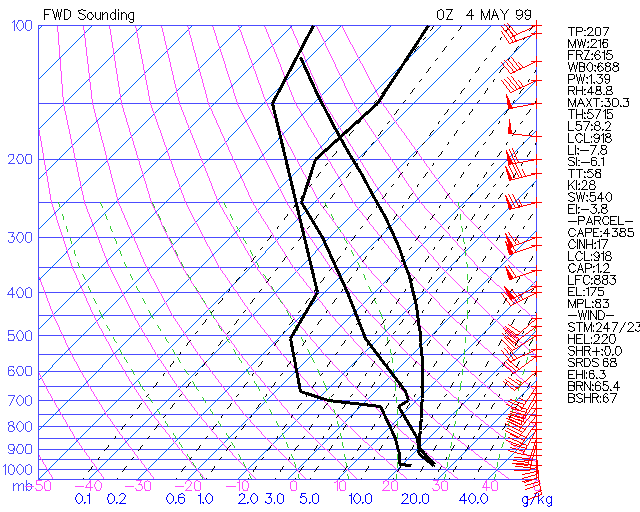
1. What is Tdd? Tdd (Dewpoint Depression) is the difference (delta) between the temperature and dewpoint at the surface and any pressure level aloft. 2. How is Tdd determined? Tdd = Temperature minus Dewpoint. Thus-- Tdd can never be negative in earth's troposphere since the temperature is always greater than or equal to the dewpoint. In the sounding at the bottom, the surface Tdd is 4 (delta C) while the 600 mb Tdd is 20 (delta C). 3. Operational significance of Tdd: Cloud bases: When the low level Tdd is small and surface lifting occurs, clouds will have low bases. When the low level Tdd is large and surface lifting occurs, clouds will have high bases (takes much more lifting to saturate the air). Severe Weather: Severe weather will be enhanced in situations in which dry mid-level air is in place along with the other parameters favorable for severe weather. Dry mid-level air (Tdd > 10 delta C anywhere between 700 and 500 mb) enhances evaporative cooling and thus downdraft strength (cooling a parcel of air makes it more negatively buoyant). Evaporative cooling also lowers the freezing level-- thus enhancing hail potential. Precipitation: Low Tdd along with lifting will produce precipitation. It is easier to saturate air by lifting it when it already has a higher RH (low Tdd). 4. Pitfalls: a. Tdd is NOT a temperature but rather a temperature difference. Suppose the temperature is 20 C with a dewpoint of 7 C. The Tdd is 20 C - 7 C = 13. The 13 refers to 13 increments of C-- NOT an ambient temperature of 13 C.  |